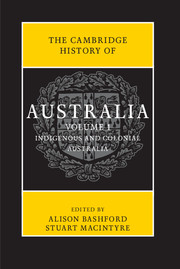Book contents
- Frontmatter
- Contents
- Abbreviations
- List of maps
- List of figures
- List of tables
- Notes on contributors
- Map
- Preface
- Introduction
- PART I
- PART II
- Further reading
- Chronology
- Index
- Frontmatter
- Contents
- Abbreviations
- List of maps
- List of figures
- List of tables
- Notes on contributors
- Map
- Preface
- Introduction
- PART I
- 1 Nation building, 1901–14
- 2 The Great War and its aftermath, 1914–22
- 3 Search for a solution, 1923–39
- 4 World War 2 and post-war reconstruction, 1939–49
- 5 The Menzies era, 1950–66
- 6 Instability, 1966–82
- 7 Growth resumed, 1983–2000
- 8 The new millennium
- PART II
- Further reading
- Chronology
- Index
8 - The new millennium
from PART I
Published online by Cambridge University Press: 05 November 2013
- Frontmatter
- Contents
- Abbreviations
- List of maps
- List of figures
- List of tables
- Notes on contributors
- Map
- Preface
- Introduction
- PART I
- PART II
- Further reading
- Chronology
- Index
- Frontmatter
- Contents
- Abbreviations
- List of maps
- List of figures
- List of tables
- Notes on contributors
- Map
- Preface
- Introduction
- PART I
- 1 Nation building, 1901–14
- 2 The Great War and its aftermath, 1914–22
- 3 Search for a solution, 1923–39
- 4 World War 2 and post-war reconstruction, 1939–49
- 5 The Menzies era, 1950–66
- 6 Instability, 1966–82
- 7 Growth resumed, 1983–2000
- 8 The new millennium
- PART II
- Further reading
- Chronology
- Index
Summary
‘At the beginning of the last decade of the twentieth century’, John Edwards, an economist and former adviser to Paul Keating observed two years before the global financial crisis (GFC), ‘something happened in Australia that had never happened before’. What had happened and continued into the new century was ‘an economic expansion so sustained, so deep and widespread in its impact, so novel in its characteristics, that the lives of Australians, their hopes and plans, their work and leisure, their wealth and incomes, the way they saw themselves and their country and the ways it related to other countries, even the way they thought about their past, began to be changed by it’.
Until its defeat in 2007, the Liberal–National Party Coalition government led by John Howard was buoyed by the boom. Elected in 1996, Howard's campaign was informed by research suggesting that Labor voters had come to feel that they had been ignored in favour of ‘minorities’. Under Labor, it was the ‘minorities’ – not ‘ordinary people’ – who ‘were being listened to and were the winners’. Those on ‘welfare’ were winners at ‘the bottom’ and those with ‘lurks and perks’ were winners at ‘the top’. But winners, on this view, were also the new and apparently powerful social constituencies: among others, migrants, Indigenous people, feminists, gays and the Greens.
Re-elected in 1998, despite its promise to introduce a goods and services tax (GST), the Coalition increased its majority in October 2001, thanks to the terrorist attacks in the United States on 9/11 and its attitude towards asylum seekers who arrived in September 2001. Its punitive policy on asylum seekers helped it take votes from Pauline Hanson's One Nation, a party of the radical right that in 1998 had won 8.4 per cent of the vote. In 2004 the Coalition increased its majority again and won a majority in the Senate; low interest rates, the threat of terrorism and the weakness of the Labor leadership all worked in its favour.
- Type
- Chapter
- Information
- The Cambridge History of Australia , pp. 187 - 212Publisher: Cambridge University PressPrint publication year: 2013
- 4
- Cited by



